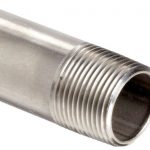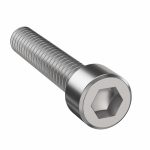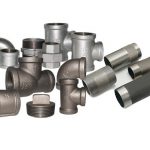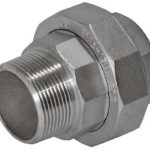A pipe thread size chart allows engineers and other technical professionals to quickly determine mating suitability in a male-female connection. Moreover, these charts are according to industry standards and various thread styles. In this article, we review ways of identifying thread types, pipe thread size chart for NPT, BSP, JIS, SAE, and metric thread styles.
Ways of Identifying a Thread Style
Before looking at the different standards and their corresponding pipe thread size chart, it is necessary to highlight the difference between thread styles. Moreover, determining these differences depends on certain parameters in the following sections.
Male Thread vs Female Thread
The basic classification of thread style is male or female. For male threads, the device possesses threads on the outside, while its female counterpart has grooves on the inside. Although this has no impact on the functionality of the thread, it is a means of distinguishing parts of a connection. When paired together, a male-female connection constitutes a joint.
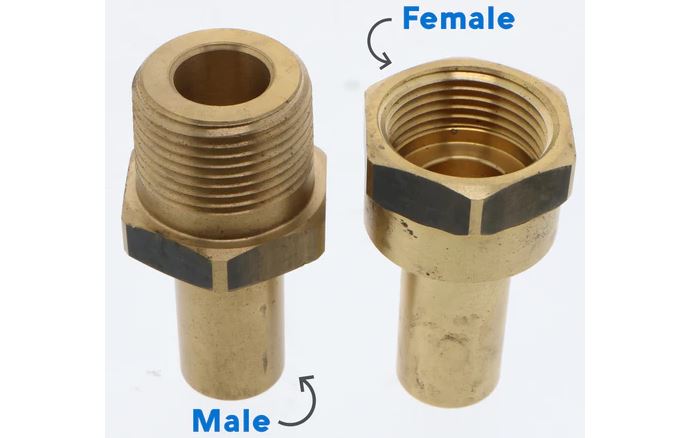
Straight Thread vs Tapered Thread
Another categorization of threads is straight and tapered. Tapered threads become narrower as they extend outwards, thus, having a smaller diameter at its tip. So, sealing of tapered connections occurs by simply wedging the male and female parts together.
On the other hand, straight threads maintain the same diameter throughout the length of the pipe thread. As a result, there is a need for a washer or alternative bonding to accomplish sealing for straight threaded joints.
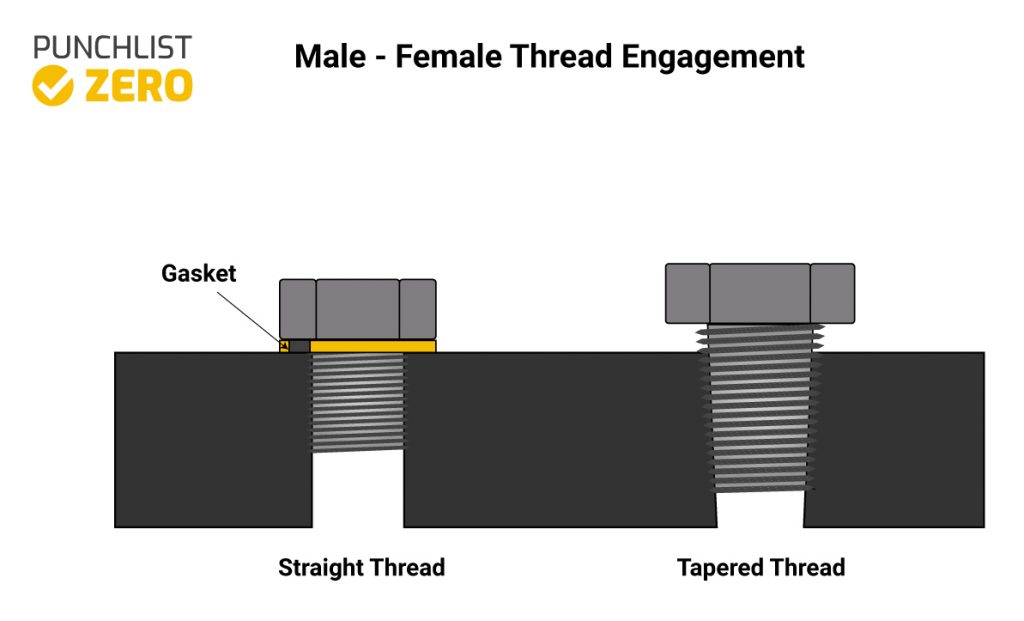
Pitch Size
One of the key features that characterize a pipe thread size is pitch size. A thread’s pitch size is the number of threads per inch on the imperial scale. While for metric thread types, it is the distance between subsequent threads. Using a pitch gauge is ideal for taking these measurements because they are often similar with marginal differences.
NPT Pipe Thread Size Chart
The NPT, which stands for National Pipe Taper, is the predominant thread style in North America. As the name implies, it has a self-sealing tapered diameter that compresses against each other after tightening. However, it is advisable in some applications to use PTFE tape or another sealant compound to guarantee a leak-tight seal. In addition, lubricating the threads reduces corrosion and enables easy loosening of the connection. Such lubrication in some scenarios is not advisable – for instance, see “Should You use Anti-Seize on a Spark Plug?
An NPT pipe thread size chart spans from nominal sizes of 1/8 inches to 2 inches. Other parameters include the threads per inch (pitch size), the outside diameter of the male thread, and the inside diameter of the female thread.
| Nominal Size | Threads per inch | Male Thread Outside Diameter (inch) | Female Thread Inside Diameter (inch) |
| 1/8 | 27 | 0.41 | 0.37 |
| 1/4 | 18 | 0.54 | 0.49 |
| 3/8 | 18 | 0.68 | 0.62 |
| 1/2 | 14 | 0.84 | 0.76 |
| 5/8 | 14 | 0.90 | 0.83 |
| 3/4 | 14 | 1.06 | 0.98 |
| 1 | 11½ | 1.31 | 1.24 |
| 1¼ | 11½ | 1.66 | 1.58 |
| 1½ | 11½ | 1.90 | 1.82 |
| 2 | 11½ | 2.38 | 2.29 |
| 2½ | 8 | 2.88 | 2.76 |
| 3 | 8 | 3.50 | 3.38 |
| 3½ | 8 | 4.00 | 3.88 |
| 4 | 8 | 4.50 | 4.38 |
| 5 | 8 | 5.56 | 5.45 |
| 6 | 8 | 6.63 | 6.51 |
| 8 | 8 | 8.63 | 8.50 |
| 10 | 8 | 10.75 | 10.62 |
| 12 | 8 | 12.75 | 12.62 |
| 14 | 8 | 14.00 | 13.87 |
| 16 | 8 | 16.00 | 15.87 |
Sizes outside the range in this NPT pipe thread size chart are uncommon, although 1/16″ could serve in air compression applications.
BS Pipe Thread Size Chart
The British Standard Pipe thread is based on a set of European technical standards for interconnecting and sealing pipe ends. Unlike NPT, it has two types. First is the BSPP for parallel threads, while the BSPT is for tapered threads. The pipe thread size chart below shows the parameters and common uses of the BSP.
| Nominal Size | Threads per inch | Male Thread Outside Diameter (inch) | Female Thread Inside Diameter (inch) | Typical Uses |
| 1/8 | 28 | 0.38 | 0.35 | Compressed air connectors |
| 1/4 | 19 | 0.52 | 0.47 | Compressed air connectors |
| 3/8 | 19 | 0.65 | 0.60 | Central heating oil line connectors |
| 1/2 | 14 | 0.82 | 0.75 | Shower hoses, radiator connectors, and kitchen/bathroom sinks |
| 5/8 | 14 | 0.88 | 0.80 | Old outside tap outlets |
| 3/4 | 14 | 1.04 | 0.97 | Washing machine inlet hose, bath taps, and modern outside tap outlets |
| 1 | 11 | 1.30 | 1.22 | Domestic heating boilers |
| 1¼ | 11 | 1.65 | 1.56 | Bathroom sink |
| 1½ | 11 | 1.88 | 1.79 | Toilet syphon outlet |
| 2 | 11 | 2.35 | 2.26 | Immersion water heater elements |
| 2½ | 11 | 2.96 | 2.85 | Immersion water heater elements |
| 3 | 11 | 3.46 | 3.36 | |
| 4 | 11 | 4.45 | 4.35 | |
| 5 | 11 | 5.45 | 5.33 | |
| 6 | 11 | 6.45 | 6.32 |
JIS Pipe Thread Size Chart
The JIS thread type, which is also known as PT, is another tapered thread style that is interchangeable with the BSPT thread. As a result, they have identical pitch sizes as the pipe thread size charts below highlights. But the male PT is not compatible with the female BSPP because it does not have 30° flare. Like the NPT, the use of a thread sealant to ensure a leak-free seal is recommended.
| Nominal Size | Threads per inch | Male Thread Outside Diameter (inch) | Female Thread Inside Diameter (inch) |
| 1/8 | 28 | 0.37 | 0.32 |
| 1/4 | 19 | 0.53 | 0.49 |
| 3/8 | 19 | 0.68 | 0.62 |
| 1/2 | 14 | 0.84 | 0.77 |
| 5/8 | 14 | 0.91 | 0.81 |
| 3/4 | 14 | 1.06 | 1.00 |
| 1 | 11 | 1.34 | 1.25 |
| 1¼ | 11 | 1.68 | 1.59 |
| 1½ | 11 | 1.90 | 1.81 |
| 2 | 11 | 2.37 | 2.29 |
SAE Pipe Thread Size Chart
The SAE thread is a straight/parallel thread style. Moreover, it deploys an efficient 90-durometer Buna-N O-Ring that enables it to provide a leak-free seal. Also, the presence of this O-Ring eliminates the need for the crushing together of the male and female threads to achieve sealing. Thus, making this a highly reliable and reusable thread type.
| Nominal Size | Threads per inch | Male Thread Outside Diameter (inch) | Female Thread Inside Diameter (inch) |
| 1/8 | 24 | 0.31 | 0.27 |
| 3/16 | 24 | 0.38 | 0.34 |
| 1/4 | 20 | 0.44 | 0.39 |
| 5/16 | 20 | 0.50 | 0.45 |
| 3/8 | 18 | 0.56 | 0.51 |
| 1/2 | 16 | 0.75 | 0.67 |
| 5/8 | 14 | 0.88 | 0.80 |
| 3/4 | 12 | 1.06 | 0.98 |
| 7/8 | 12 | 1.18 | 1.09 |
| 1 | 12 | 1.31 | 1.22 |
| 1¼ | 12 | 1.63 | 1.54 |
| 1½ | 12 | 1.88 | 1.79 |
| 2 | 12 | 2.50 | 2.41 |
ISO Metric Thread
The Metric Thread type comes in both parallel and straight versions and is predominant in Europe. Unlike the previous thread styles, its pipe thread size chart quotes the thread pitch in millimeters, instead of threads per inch/millimeters. Also, for each diameter, there are two different pitch sizes, which are the fine pitch and coarse pitch. The metric pipe thread charts vary depending on the ISO standard it is based on. Below is a subset of ISO 262 used for certain sizes of screws, bolts, and nuts.
| Nominal Diameter (mm) | Coarse Pitch (mm) | Fine Pitch (mm) |
| 1 | 0.25 | 0.20 |
| 1.2 | 0.25 | 0.20 |
| 1.4 | 0.3 | 0.20 |
| 1.6 | 0.35 | 0.20 |
| 1.8 | 0.35 | 0.20 |
| 2 | 0.40 | 0.25 |
| 2.5 | 0.45 | 0.35 |
| 3 | 0.50 | 0.35 |
| 3.5 | 0.60 | 0.35 |
| 4 | 0.60 | 0.50 |
| 5 | 0.70 | 0.50 |
| 6 | 0.80 | 0.75 |
| 7 | 1.00 | 0.75 |
| 8 | 1.00 | 0.75 or 1.25 |
| 10 | 1.50 | 1.00 or 1.25 |
| 12 | 1.75 | 1.25 or 1.50 |
| 14 | 2 | 1.50 |
| 16 | 2 | 1.50 |
| 18 | 2.5 | 1.50 or 2.00 |
| 20 | 2.5 | 1.50 or 2.00 |
| 22 | 2.5 | 1.50 or 2.00 |
| 24 | 3.0 | 2.00 |
| 27 | 3.0 | 2.00 |
| 30 | 3.5 | 2.00 |
| 33 | 3.5 | 2.00 |
| 36 | 4.0 | 3.00 |
| 39 | 4.0 | 3.00 |
| 42 | 4.5 | 3.00 |
| 45 | 4.5 | 3.00 |
| 48 | 5.0 | 3.00 |
| 52 | 5.0 | 4.00 |
| 56 | 5.5 | 4.00 |
| 60 | 5.5 | 4.00 |
| 64 | 6 | 4.00 |
Unified Thread Standard
The Unified Thread Standard (UTS) is like the Metric Thread in that they have both coarse and fine pitch sizes for each diameter. Also, the threads of this standard have a flank angle of 30° and are symmetrical. Thereby, it produces the same 60° profile as the ISO Metric Thread. Nevertheless, its characteristic dimensions are in imperial units as the ASME, and ANSI controls the standard. Below is a pipe thread size chart for the UTS specifying the threads per inch (TPI) for the coarse (UNC) and fine (UNF) threads.
| Major Diameter (inch) | UNC (TPI) | UNF (TPI) |
| #1 (0.073) | 64 | 72 |
| #2 (0.086) | 56 | 64 |
| #3 (0.099) | 48 | 56 |
| #4 (0.112) | 40 | 48 |
| #5 (0.125) | 40 | 44 |
| #6 (0.138) | 32 | 40 |
| #8 (0.164) | 32 | 36 |
| #10 (0.190) | 24 | 32 |
| #12 (0.216) | 24 | 28 |
| ¼ | 20 | 28 |
| 5/16 | 18 | 24 |
| 3/8 | 16 | 24 |
| 7/16 | 14 | 20 |
| ½ | 13 | 20 |
| 9/16 | 12 | 18 |
| 5/8 | 11 | 18 |
| ¾ | 10 | 16 |
| 7/8 | 9 | 14 |
| 1 | 8 | 12 |
| 1 1/8 | 7 | 12 |
| 1 ¼ | 7 | 12 |
| 1 3/8 | 6 | 12 |
| 1 ½ | 6 | 12 |
